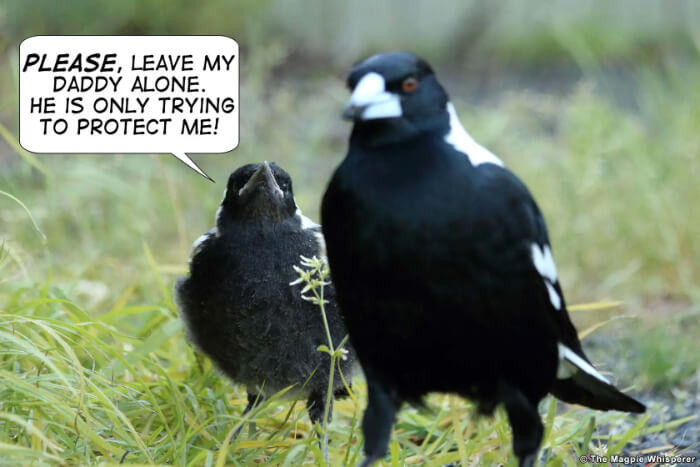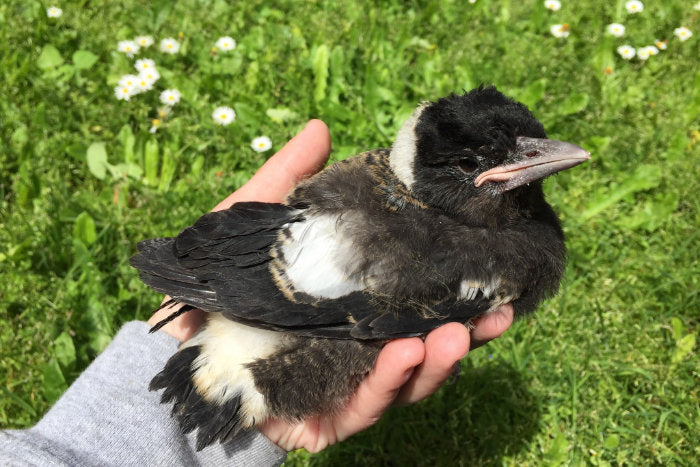Crafting a Cosy Nest for Magpie Hatchlings & Nestlings
Posted by The Magpie Whisperer on

In the world of wildlife, there's nothing quite as heartwarming as witnessing the tender care magpie parents shower upon their young ones. However, life can throw unexpected challenges, causing baby birds to tumble from their nests, be it due to accidents or unforgiving weather. It's in these moments of vulnerability that a kind and compassionate intervention can truly work wonders!
Our comprehensive guide is here to be your trusted companion, offering step-by-step instructions on creating a secure makeshift nest and placing it with the utmost care. This ensures that the devoted magpie parents can continue their nurturing efforts, guiding their precious offspring until it's time for the exciting journey of branching out into the world.
Ensuring the Well-Being of the Baby Bird
💡 Always keep in mind that the baby bird's well-being is the top priority. Taking prompt action and seeking professional assistance can greatly increase its chances of recovering and eventually returning to its natural home.
- Before beginning the examination, it's crucial to ensure the safety of both yourself and the bird. Examine the bird away from its parents to prevent them from swooping and causing distress. This will reduce stress for both the baby bird and its parents, making the examination process more effective.
-
Begin by gently inspecting the young bird, paying close attention to its wings, legs, and body. Look for any visible injuries, including cuts, bruises, blood, signs of open-beak breathing, wheezing, labored breathing, clicking sounds, or wounds. Take your time and carefully feel along its wings and legs to check for any unusual lumps, which might indicate fractures.
-
Besides external injuries, keep an eye out for signs of potential internal issues, which may not be immediately visible.
-
If you spot any injuries or suspect that the bird is unwell, don't hesitate to take action in its best interest. Contact your local wildlife organisation immediately; they have the knowledge and resources for the right care and rehabilitation. If you believe the bird is gravely ill or badly injured, please take it to a wildlife-friendly veterinarian for a thorough examination and any necessary medical assistance.
Crafting a Makeshift Nest When Returning to the Original Nest Is Not an Option
🪹 If you ever find yourself in a situation where returning the bird safely to its original nest becomes impossible due to its location or damage, the next best course of action is to create a makeshift nest.
For this particular nest, we used the following materials:

Hanging basket with coconut fiber liner: These hanging baskets, complete with a coconut fiber liner, are commonly available at stores like Bunnings and various $2 shops. The coconut fiber liner serves as an ideal nest-building material because of its natural texture and durability. It provides a soft and secure foundation for the baby bird, mimicking the cosiness of a real nest.
Pasture straw: Pasture straw is a readily accessible material that you can find in pet stores and select supermarkets. It's an excellent choice for nest-making due to its softness and warmth. The straw helps create a comfortable and insulated environment inside the makeshift nest, ensuring the baby bird stays snug and protected.
Animal Fur: Animal fur, being soft, adds a layer of comfort and cushioning to the nest.
Additionally, you can incorporate natural materials like grass and leaves into the makeshift nest.

Cable ties: Cable ties play a crucial role in ensuring the safety of the baby bird within the nest. By using cable ties, you can securely fasten the coconut fiber liner in place within the hanging basket. This prevents any risk of the bird becoming entangled in the wire bar spacing, which could be potentially harmful.
Octopus straps/elastic straps: To ensure the nest is firmly anchored to the tree branch, octopus straps, elastic straps, are used. These materials provide stability and prevent the nest from swaying or falling, keeping the baby bird safe and comfortable.
Essential Tools for a Successful Nest Placement
Ladder: A ladder is an invaluable tool when it comes to safely placing the nest in a tree. It provides you with the necessary height and stability to reach the chosen branch and securely position the nest.
Assistant: For an extra layer of safety and convenience, involving a trusted friend or family member as an assistant can prove invaluable. They can help stabilise the ladder and hand you the nest for placement.
Helmet: It is strongly advised to wear a helmet or head protection when attempting to place the nest. This precaution is essential not only for your safety in case of a fall from the tree but also to shield yourself from the distressed swooping magpies concerned about their little one.
Ensuring Parent Recognition and Awareness: Observing the Parents
Before you proceed with placing the nest, it's crucial to confirm that the parents are fully aware of their baby's presence. To do this, gently place the baby in an open carrier or cardboard box where the parents can easily spot the baby, then step back and give the parents some space to attend to and feed their young one.
This step is essential for reestablishing the parent-child bond and ensuring that the baby will be well-cared for once it's safely nestled in its new home.
If the parents are attentive to the baby, proceed with placing the makeshift nest.
Makeshift Nest Placement

Location, location, location!
When selecting a location for your makeshift nest, it's a smart move to position it as closely as possible to where you suspect the original nest was or currently is. This considerate placement significantly increases the chances of the parents recognising the new nest with their precious baby inside. It's important to keep in mind that magpies are highly territorial birds, so avoid placing the nest near a neighbouring territory to ensure the best outcome for the baby bird.
It's essential to ensure that it's not placed in direct sunlight. This precaution is crucial because direct sunlight can lead to overheating, which can be harmful to the baby bird. Additionally, make sure it's easily accessible for the parents to reach. Instead, position it as high as safely possible in a sheltered area that provides protection from predators, strong winds, and rain.
To ensure the nest is securely in place, follow these steps as demonstrated:
- Gently tug on the nest to assess its stability. It should be securely anchored to the branch or branches.
- Press down on the edges of the nest to confirm that it's securely fastened and won't easily sway or shift.
- Observe the nest for any signs of movement or instability, especially in response to wind.
- If you've used any additional securing materials like ropes, inspect them to ensure they are tight and reliable.
Observing Parental Care: A Crucial Step
The parents need to know where to find their baby bird. Hopefully they have been watching and spotted their baby. After they've located the baby bird, be sure to observe the parents foraging and returning to the nest to feed the baby. Regular observation provides confirmation that the parents have accepted the new nest and are actively caring for the returned bird.
If your nest placement proves successful, congratulations on your compassionate effort! To further ensure the well-being of the baby bird, consider revisiting the nest the following day and observing the parents' behavior to ensure the baby magpie is being attended to. This additional check serves as an important precautionary step.
If All Else Fails!
If you find yourself in a situation where the parents of a baby bird don't seem to be caring for it in either the old or new nest, you can take steps to ensure the bird's well-being. Here's what to do next:
Observe Carefully: First, ensure that the parents are indeed not attending to the baby bird. Sometimes, they may temporarily leave the nest to forage for food and will return later. Monitor the situation for a reasonable amount of time to be sure.
Contact Local Wildlife Experts: Reach out to your local wildlife organisation or a wildlife rehabilitator. They possess the expertise and resources to assess the situation and provide appropriate care for the baby bird. They can also offer guidance on the best course of action.
Do Not Feed or Provide Water to the Bird: It's essential not to attempt to feed the baby bird on your own. Feeding it without proper knowledge can be harmful. Wildlife experts will be well-versed in the appropriate diet and feeding methods.
Provide Information: When you contact the wildlife organisation, provide them with all relevant information, including the species of the bird, its age (if known), exact location, and any observations you've made about its condition.



